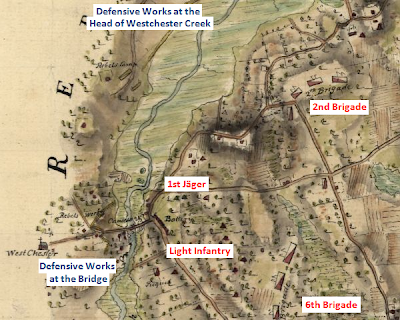From October 8th to November 1st, I am blogging about the White Plains “campaign” of 1776.Click here for an overview of this project, a listing of the sources used, and other general information.
Synopsis for October 13th: The Americans brought reinforcements into Westchester County; the British prepared for their next move.
Previous entry: October 12th; next: October 14th.
Major-General William Heath commanded the American troops in lower Westchester County. He observed that at Throg’s Neck “a large number of vessels, ships, brigs, schooners, sloops… etc.” were at anchor offshore. During the night of October 12-13, “[their] lanthorns were lighted and hung out at their yard arms which made a very extraordinary appearance.”
The Americans suspected the landing on Throg’s Neck was only a feint, and they thought the British might make a new landing elsewhere. Sure enough, the British showed no signs of attempting to force their way overland from Throg’s Neck. Instead, there was only scattered firing between the armies. According to Heath, “Captain Bryant [of Knox’s Artillery Regiment], now and then… saluted the British with a field-piece.”
To prepare against the various possible British moves, the Americans poured reinforcements into Westchester County. Alexander McDougall’s marched into Westchester County from Manhattan, and the brigades of John Glover and John Nixon were sent across the Hudson from New Jersey to Kingsbridge.
Screenshot of a Google Maps satellite view of Throg’s Neck (click to enlarge). The marked sites of the British landing and of Westchester Creek bridge are based on the Charles Blaskowitz map, shown partially below.
Excerpt of a Charles Blaskowitz showing the position of British and American forces on either side of Westchester Creek (click to enlarge). The American positions at the bridge (lower left) and at the head of the creek (upper left) were defended by troops from Colonel Edward Hand’s Pennsylvania brigade, Colonel William Prescott’s 7th Continental Regiment, Colonel Morris Graham’s New York militia regiment, and a couple of pieces of artillery. These troops (among others) were commanded by Major-General William Heath. Only part of the British army is visible. Blaskowitz depicted close to the bridge some companies of British light infantry (the red triangles), the 1st Jäger Company (two green triangles), and a detachment of light dragoons (the red and white square). Near the head of the creek is the 2nd British brigade (5th, 28th, 35th, 49th regiments of foot). The rest of the British army was encamped to the east or southeast.
The Throg’s Neck area is today heavily urbanized. The image below (screenshot using Google Maps) shows that the humble Westchester Creek Bridge has given way to several major traffic arteries.
British Commissary Charles Stedman later criticized Lieutenant-General William Howe for not immediately making another move. He called the landing on Throg’s Neck a “mistake” and said that it “should have been remedied instantly, by pushing along some other route”. The British landing craft were on hand, and the troops were already carrying provisions for this day and the next, but no move was made. Howe explained later that another move “would have been an imprudent measure, as it could not have been executed without much unnecessary risk.” Instead, Howe decided to wait until he was more fully prepared. During this time, he later wrote, “we were employed in getting up stores and provisions” and “the carriages and horses for transporting provisions, artillery, ammunition, and baggage.” More men were on the way as well.



No comments:
Post a Comment